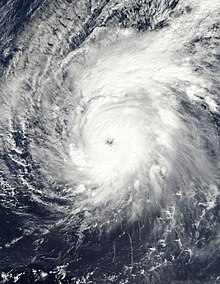
Back Tifón Pongsona Spanish Typhon Pongsona French 태풍 봉선화 Korean Tufão Pongsona Portuguese Bão Pongsona (2002) Vietnamese 颱風鳳仙 Chinese Hong-thai Pongsona (2002 nî) ZH-MIN-NAN
|name=. Remove this parameter; the article title is used as the name by default. Typhoon Pongsona near peak intensity on December 8 | |
| Meteorological history | |
|---|---|
| Formed | December 2, 2002 |
| Extratropical | December 11, 2002 |
| Dissipated | December 12, 2002 |
| Very strong typhoon | |
| 10-minute sustained (JMA) | |
| Highest winds | 165 km/h (105 mph) |
| Lowest pressure | 940 hPa (mbar); 27.76 inHg |
| Category 4-equivalent super typhoon | |
| 1-minute sustained (SSHWS/JTWC) | |
| Highest winds | 240 km/h (150 mph) |
| Lowest pressure | 910 hPa (mbar); 26.87 inHg |
| Overall effects | |
| Fatalities | 1 indirect |
| Damage | $730 million (2002 USD) |
| Areas affected | Guam, Northern Mariana Islands |
| IBTrACS | |
Part of the 2002 Pacific typhoon season | |
Typhoon Pongsona was the last typhoon of the 2002 Pacific typhoon season, and was the second costliest United States disaster in 2002, only behind Hurricane Lili.[1] The name "Pongsona" was contributed by North Korea for the Pacific tropical cyclone list and is the Korean name for the garden balsam.[2] Pongsona developed out of an area of disturbed weather on December 2, and steadily intensified to reach typhoon status on December 5. On December 8 it passed through Guam and the Northern Mariana Islands while at peak intensity, with 10-minute sustained winds of 175 km/h (110 mph). It ultimately turned to the northeast, weakened, and became extratropical on December 11.
Typhoon Pongsona produced strong wind gusts peaking at 285 km/h (175 mph), which left the entire island of Guam without power and destroyed about 1,300 houses. With strong building standards and experience from repeated typhoon strikes, there were no fatalities directly related to Pongsona, although there was one indirect death from flying glass. Damage on the island totaled over $730 million (2002 USD, $1.24 billion 2024 USD), making Pongsona among the five costliest typhoons on the island. The typhoon also caused extreme damage on Rota and elsewhere in the Northern Mariana Islands, and as a result of its impact the name was retired.
- ^ Federal Emergency Management Agency (2003). "Super Typhoon Pongsona: The First 100 Days Over $300 Million In Disaster Relief And Assistance". Retrieved 2013-01-02.
- ^ Gary Padgett (2003). "Tropical Cyclone Summary for December 2002". Retrieved 2006-07-19.